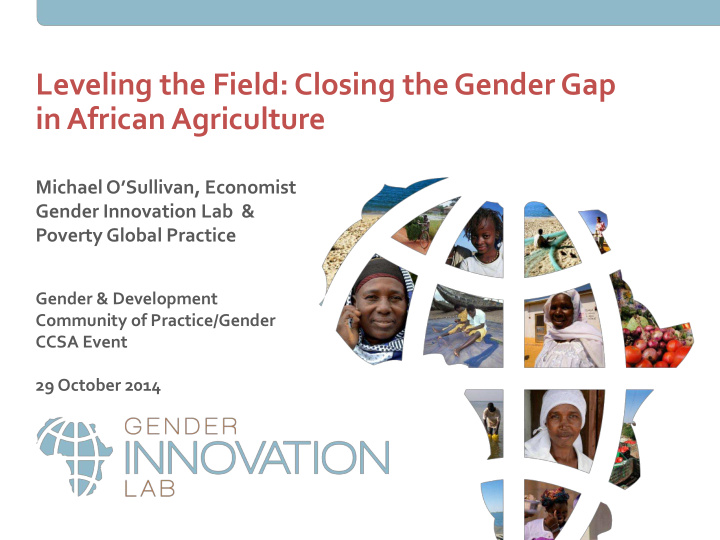



Leveling the Field: Closing the Gender Gap in African Agriculture Michael O’Sullivan, Economist Gender Innovation Lab & Poverty Global Practice Gender & Development Community of Practice/Gender CCSA Event 29 October 2014
Partners
Photo credit: UC Davis
Image source: UN Food and Agriculture Organization (FAO) http://www.fao.org/sofa/gender/en/
Photo credits: LSMS-ISA
Photo credit: Wikimedia Commons
Is equalizing access enough? x x “ If women had the same “ In agriculture, gender access to productive resources differences almost always as men, they could increase disappear ... ” yields … ”
Gaps in returns also matter 1 kg of fertilizer (quantity) Yield from 1 kg of fertilizer (returns) Male farmer after harvesting Female farmer after harvesting
What are the facts?
How much less do women produce per hectare?
Quantities Returns (82% of the gap) (18% of the gap) House- High- Farm Inorganic House- Inorganic Child hold value implements fertilizer hold fertilizer dependency male export male ratio labor crops labor Source: T. Kilic, A. Palacios-Lopez & M. Goldstein. 2013. “Caught in a Productivity Trap: A Distributional Perspective on Gender Differences in Malawian Agriculture. ” World Bank Policy Research Working Paper #6381.
Quantities Returns (43% of the gap) (57% of the gap) Ag House- Land Women’s Land Fertilizer extension hold tenancy time on tenancy services labor ag activities Source: A. Aguilar, E. Carranza, M. Goldstein, T. Kilic, & G. Oseni. 2014. “Decomposition of Gender Differentials in Agricultural Productivity in Ethiopia. ” World Bank Policy Research Working Paper #6764.
What’s driving Africa’s gender gap? Quantities & returns: Returns: Quantities & returns: Farm labor Ratio of children Fertilizer (esp. male labor) to adults in the household Photo credits: LSMS-ISA & CIMMYT
How do we level the field?
LAND 1 . Strengthen women’s land rights. 2. Improve women’s access to hired labor. 3. Enhance women’s use of tools & LABOR equipment that reduce the amount of labor they require on the farm. 4. Provide community-based child- care centers. 5. Encourage women farmers to use more, & higher-quality, fertilizer. NON- LABOR INPUTS 6. Increase women’s use of improved seeds.
7. Tailor extension services to INFOR- women’s needs, and leverage social MATION networks to spread agricultural knowledge. 8. Promote women’s cultivation of ACCESS high-value/cash crops. TO 9. Facilitate women’s access to & MARKETS effective participation in markets. HUMAN 10. Raise education levels of adult CAPITAL female farmers.
Offer financing for farm labor Photo credit: Bill & Melinda Gates Foundation
Provide community child care centers Photo credit: UNICEF Uganda
Certify small bags of quality fertilizer Photo credit: AGRA Malawi
Register women’s land rights Photo credit: Development Alternatives, Inc.
Broader lessons for policy and programs • Look for complementarities in programming • Partner with the private sector • Recognize when to stop a program • Channel interventions through women’s farming groups to deepen impact • Cash might be enough for some farmers
A joint collaboration of the World Bank (Gender Innovation Lab; DEC/LSMS- Integrated Surveys on Agriculture; and Agriculture Global Practice) and the ONE Campaign It’s not just the right thing to do. It’s the smart thing to do.
Recommend
More recommend